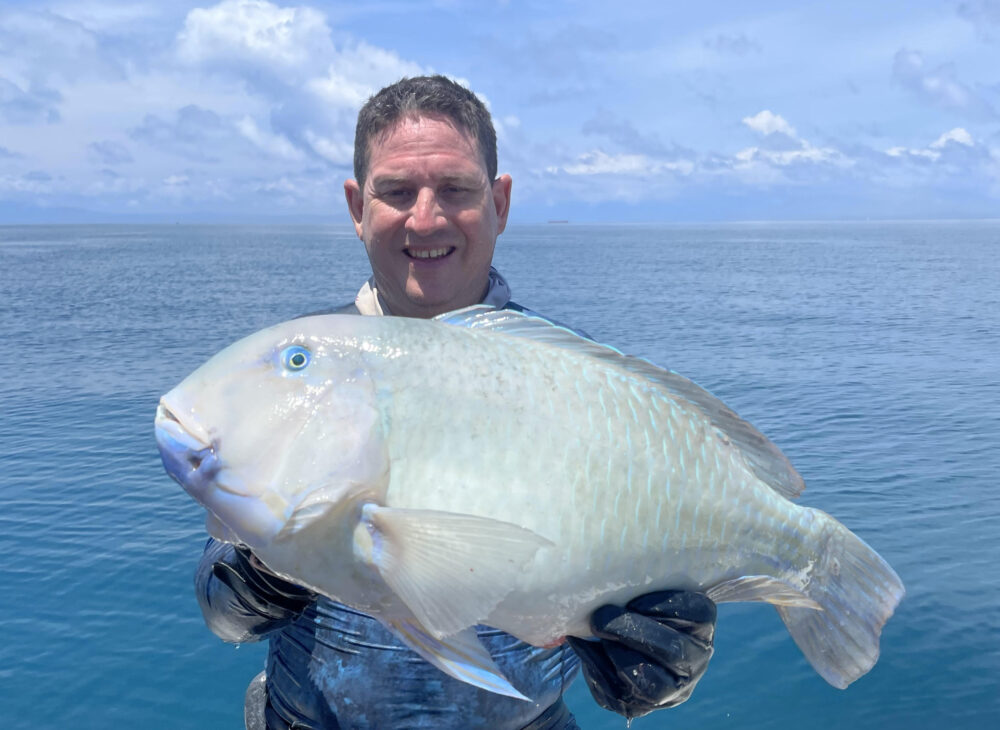Parrot Ponderings – By Anthony Davies
In the great south east of the sunshine state the fish generally known as a “Parrot” or “Bluey” is a prized capture, somewhat less so in tropical waters where anglers are a little more spoilt for choice. The more knowledgeable fishos among us might mutter “tuskfish, not parrot” under their breath, but in fact the tusk fishes and parrot fishes are related, part of the Labridae group, the wrasses.
Labridae comes from the Latin word for lip, and most members of this group have prominent, often prehensile lips to assist in feeding. In Europe they are known as “lip-fish”, “lippfische” in German, for instance. Their lips, teeth and high foreheads give these fishes a vaguely human appearance, our English word “wrasse” comes from the Cornish “wragh”, itself derived from the Celtic word for a hag or old woman.
The wrasses are a diverse group, usually found in the vicinity of rocks or reefs. They range in size from giants like the mighty Maori wrasse or the southern blue groper down to tiny fish like the well known cleaner wrasse. While researching this piece I was surprised to find that a number of coldwater wrasses also exhibit cleaning behaviour, and that some controversy has arisen over their widespread use in the salmon farming industry. Thousands of North Atlantic cleaner wrasse are caught or farmed each year to keep the salmon free of sea lice and other parasites.
The wrasses are unusual in that most will change sex depending upon their circumstances, a typical group consists of a large male and a number of smaller subordinate females. If the male disappears the largest female becomes a male and takes his place. Conversely, if two male wrasse are put in an aquarium together the smaller fish will turn female.
Wrasse are also intelligent, as far as fish go at any rate. A 2011 video shows a wrasse hurling a clam against a rock to break the shell, first time a fish has been seen using a tool.
The true parrot fishes have their teeth fused into a beak, this is used for scraping and grinding coral. Studies are ongoing as to whether they are feeding on algae, mainly found in dead coral, or the microorganisms associated with the algae. Parrotfish also eat live coral, digesting the polyps inside. They contribute significantly to reef erosion; a large parrotfish might process 90kg of coral sand in a year. Much of that pristine beach on your favourite coral cay has been through a parrotfish!
That specialized diet means that the true parrotfish are a very rare catch on hook and line. The larger ones are reasonable eating; and are a common capture for spear fishers.
Of course it’s the angling wrasse species that we are most interested in. In southern waters the blue and red gropers were thought to be different species for many years, we now know that the larger blue fish, up to 50kg, are mature males, the smaller red gropers are females. Typical wrasse curiosity made southern groper an easy spearfishing target, and numbers crashed in the 1970’s and 80’s. Now spearing one is illegal in NSW, and a strict size and bag limit applies to line fishers.
In Queensland the Humphead or Maori wrasse Cheilinus undulatus is a no-take species by any means. Big males can grow up to two metres in length and almost 200kg, they are the largest of all wrasses. Whilst not actually in danger of extinction they are a friendly and curious fish and are very popular with snorkelling tourists, I don’t think many dive operators would like to see ‘em back on the Take list. We oldies remember how delicious their white, flaky flesh used to taste.
The tusk fishes are the most popular wrasses with line fishers. Black Spot tusk fish Choerodon schoenleinii are the “Blue Parrot” of southern anglers and the Blue Tuskfish C. albigena is the “bluey” or “blue bone” of Barrier Reef waters. The smaller Venus Tuskfish C. venustus is a common catch around the Whitsundays and islands further north, and the little Purple Tuskfish C. cephalotes is the “grass parrot” of southern Queensland anglers.
Tusk fish are opportunistic feeders, although their powerful jaws and prominent tusk like teeth indicate a preference for hard shelled demersal prey like shellfish and sea urchins. They will readily take cut baits or pilchards, and most are taken as by-catch by bottom bouncing anglers targeting more prestigious reef species. They will also enthusiastically nail lures of an appropriate size, in fact most of the Venus and small blackspot tusk fish I have caught have taken smallish soft plastics. Despite their less than athletic appearance, they show a good turn of speed when rushing from cover to attack a lure, and I have no doubt that they are aggressive ambush predators at times.
Tusk fish are determined and powerful fighters when hooked; and will make use of structure to bust you off. If you win the battle and want to take the fish for the table you are in for a treat, the flesh is firm, white and flaky with a sweet flavour that reflects the tuskie’s shellfish diet. They get the name of bluey or blue bone ‘cos most species have almost fluorescent bluish green bones, a bit of a surprise for the first-time filleter.
I guess I’ve parroted on long enough about these fascinating fish, perhaps it’s time to get up close and personal with a parrot!









